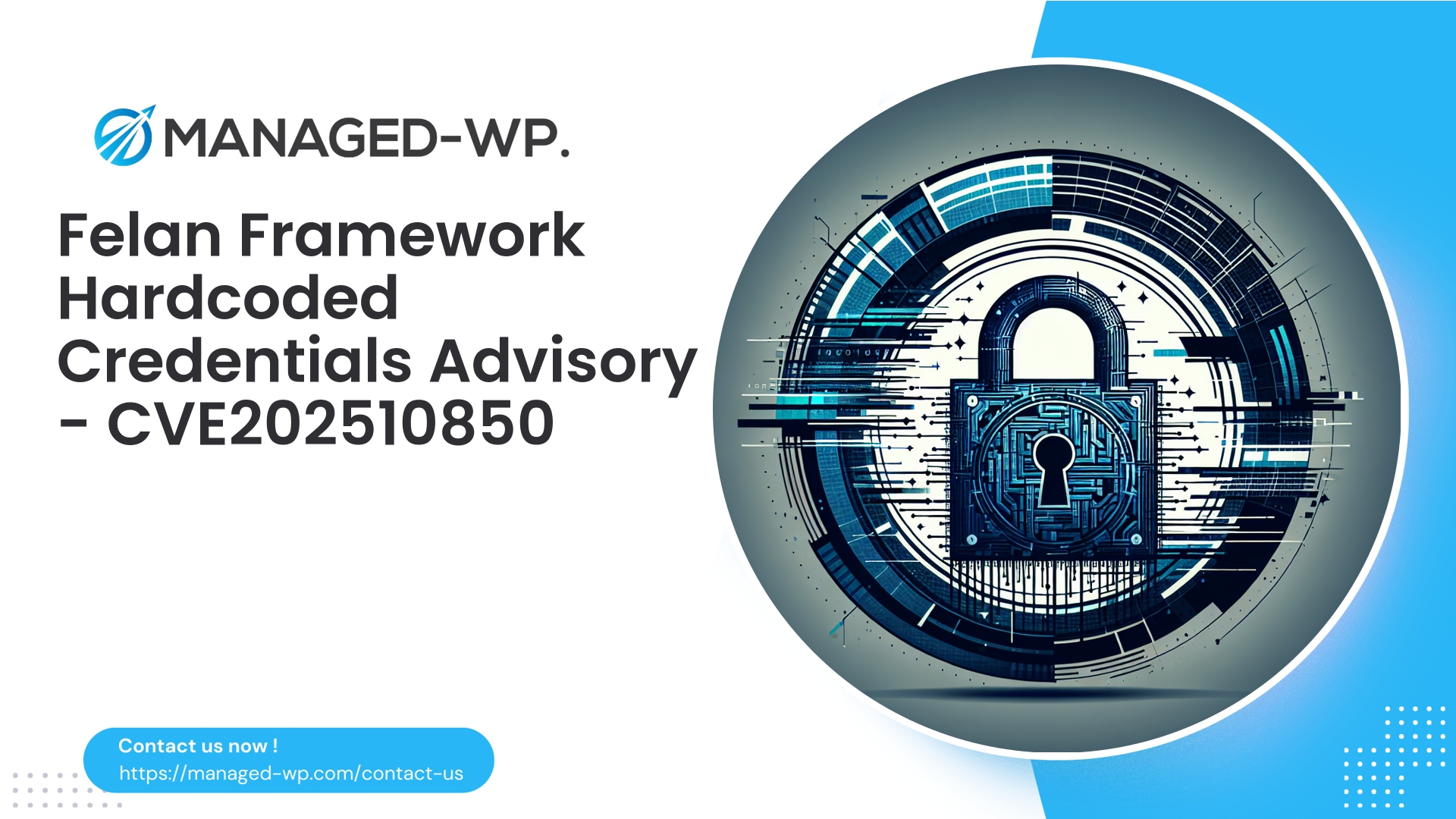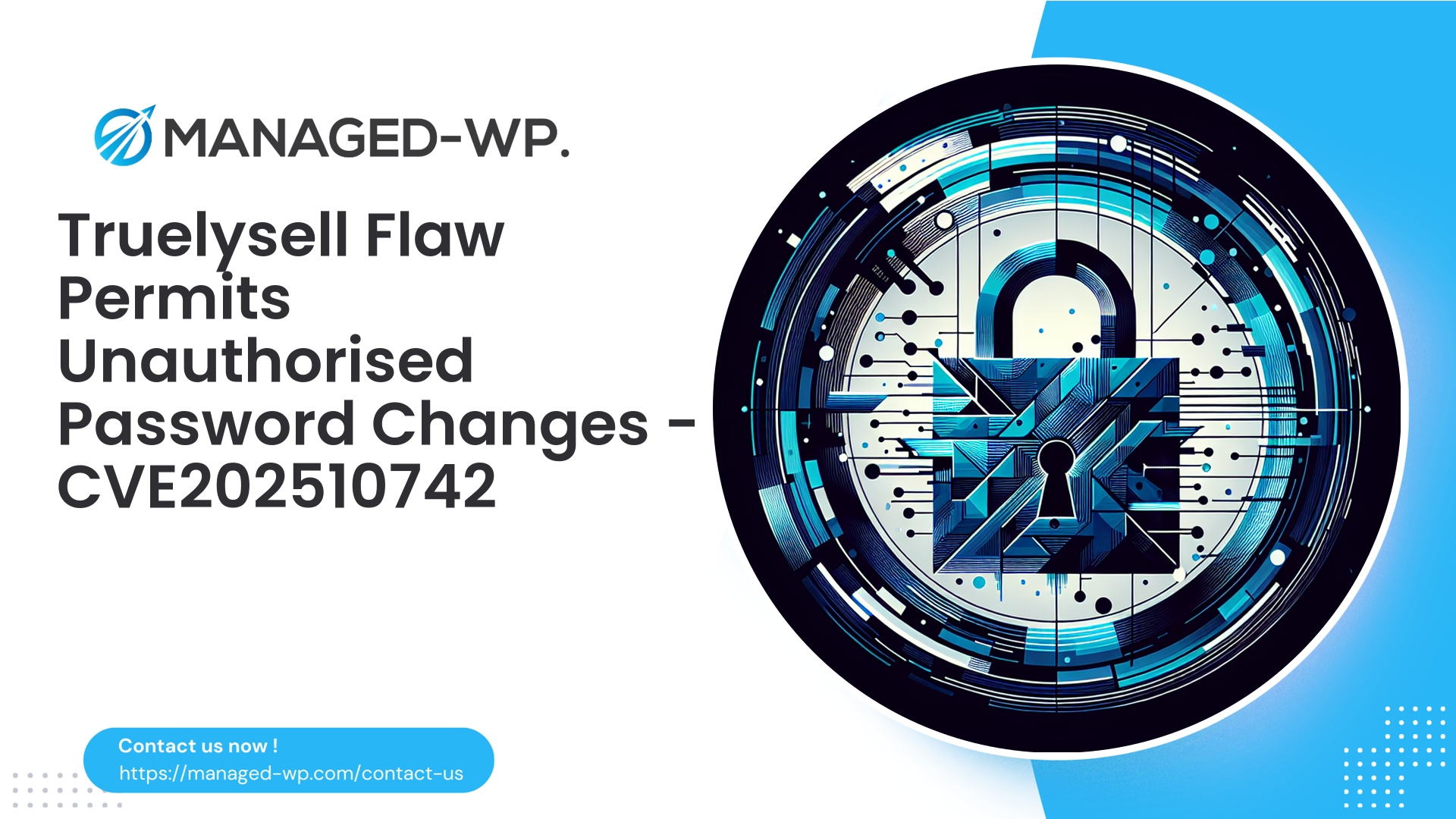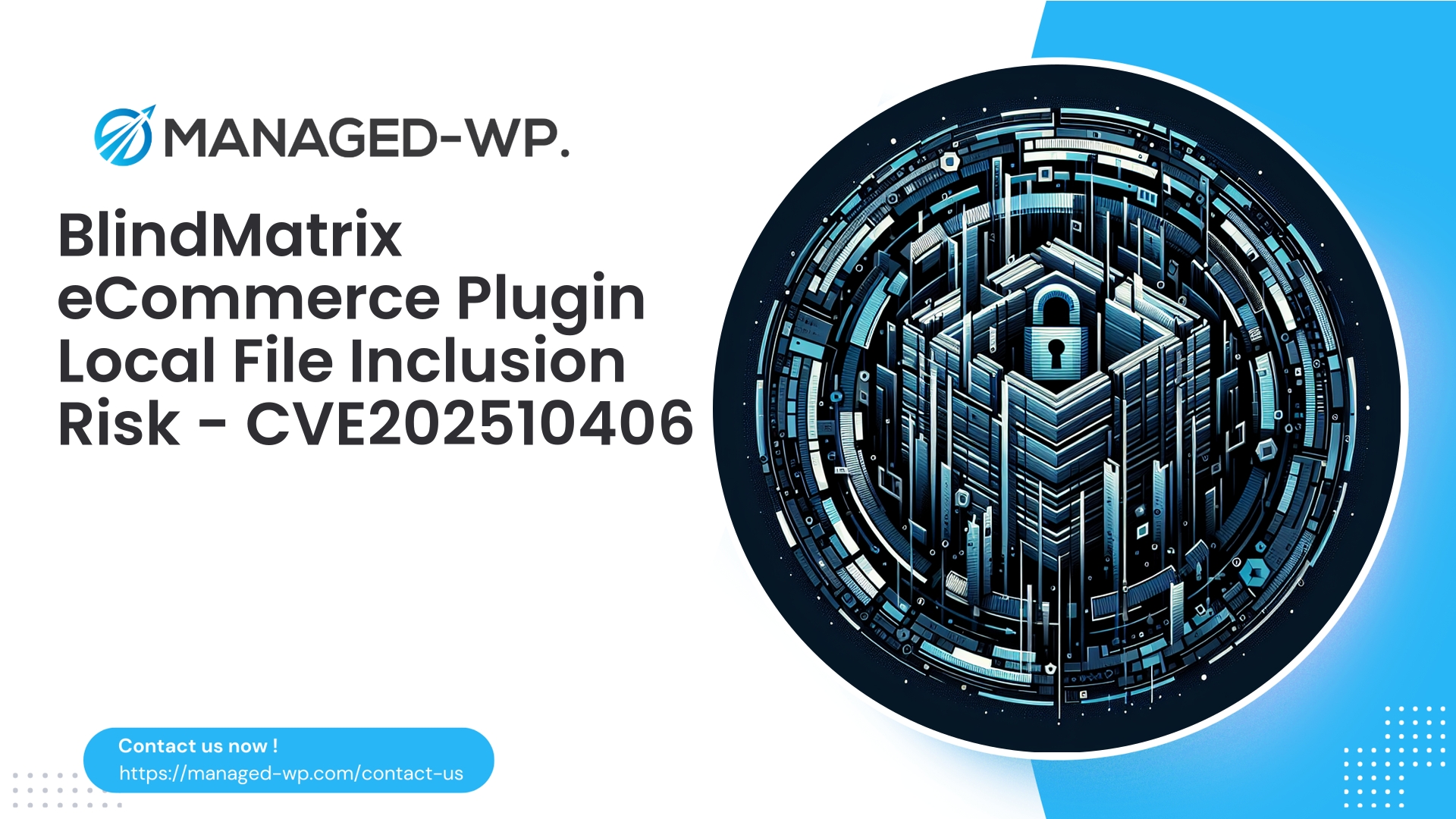| 插件名稱 | 費蘭框架 |
|---|---|
| 漏洞類型 | 硬編碼憑證 |
| CVE編號 | CVE-2025-10850 |
| 緊急 | 高的 |
| CVE 發布日期 | 2025-10-16 |
| 來源網址 | CVE-2025-10850 |
緊急安全公告 — Felan Framework 外掛程式(<= 1.1.4):硬程式編碼憑證 (CVE-2025-10850)
作者: Managed-WP 安全研究團隊
日期: 2025-10-16
標籤: WordPress、漏洞、WAF、事件回應、Felan框架
概括: Felan Framework WordPress 外掛程式(版本 <= 1.1.4)中發現了一個嚴重的驗證漏洞。此漏洞(CVE-2025-10850)暴露了硬編碼的憑證,允許未經身份驗證的攻擊者在受影響的站點中執行特權操作。此問題的 CVSS 評分為 9.8,已在 1.1.5 版本中修復。如果您的網站使用了此版本的插件,則必須立即採取行動:更新插件、控制潛在的風險,並驗證您的環境是否已被入侵。
目錄
- 發生了什麼事
- 為什麼這對 WordPress 網站所有者很重要
- 該問題的技術概要
- 攻擊者如何濫用硬編碼憑證-真實的攻擊場景
- 立即採取的行動(0-24小時)
- 遏制和緩解(當您無法立即更新時)
- 偵測和事件回應(需要注意哪些方面)
- 妥協後的恢復與強化
- 指導開發人員避免將密鑰硬編碼到程式碼中
- Managed-WP 如何保護網站免受此類風險的影響
- 立即開始保護-免費基礎保護(註冊資訊)
- 附錄:實用指令和WAF規則範例
發生了什麼事
安全專家揭露了 Felan Framework WordPress 外掛程式中存在一個驗證漏洞,該漏洞影響到 1.1.4 版本之前的所有版本。該漏洞是由於插件程式碼中直接嵌入了硬編碼的憑證造成的,未經授權的攻擊者可以利用該漏洞在無需任何身份驗證的情況下存取特權功能。
該插件的維護者已發布 1.1.5 版本,以移除這些硬編碼的憑證並妥善保護身分驗證流程。儘管已發布補丁,但由於更新延遲,許多網站仍然存在安全隱患。攻擊者通常會在安全公告發布後不久便自動執行掃描和攻擊,這使得情況更加緊迫。
為什麼這對 WordPress 網站所有者很重要
硬編碼憑證會帶來嚴重的安全風險,原因有以下幾點:
- 它們繞過了傳統的身份驗證機制,因為密鑰固定在程式碼中,並且可能被存取。
- 如果嵌入的憑證允許管理層級的存取權限或與遠端 API 進行交互,攻擊者可以新增管理員使用者、安裝惡意程式碼、提取敏感資料或在網路環境中進行橫向移動。
- 利用此漏洞無需任何身份驗證,使其完全暴露給網路上的任何攻擊者。
- CVSS 評分為 9.8,顯示存在快速、自動化大規模攻擊的高可能性。
任何執行 Felan Framework 1.1.4 或更早版本的 WordPress 安裝都必須承擔立即存在的風險,直到更新和審核為止。
該問題的技術概要
硬編碼憑證是指將固定的使用者名稱、密碼、API令牌或金鑰嵌入到原始程式碼中,使得未經授權的使用者能夠呼叫或推斷出這些資訊。例如:
- 插件函數中的靜態使用者名稱/密碼檢查,例如:
如果 ($user === 'admin' && $pass === 'secret123'). - API金鑰或令牌被硬編碼,用於驗證特權操作或API呼叫。
- 透過硬編碼令牌或憑證授權操作的後門式檢查。
在這種情況下,攻擊者會利用這些嵌入的金鑰,在未經合法身份驗證的情況下呼叫管理端點或執行遠端操作。此補丁將硬編碼的憑證替換為適當的授權機制。
CVE: CVE-2025-10850
修補: 將 Felan Framework 外掛程式升級到 1.1.5 或更高版本。
攻擊者如何濫用硬編碼憑證-真實的攻擊場景
以下是攻擊者可能採用的常見策略:
- 直接端點利用
- 該插件公開了與管理員相關的 REST 或 AJAX 端點,這些端點接受硬編碼的令牌。攻擊者可以使用這些令牌提交請求,以建立管理員帳戶、修改設定或執行任意操作。
- 從可存取的原始程式碼中竊取憑證
- 如果外掛程式檔案因配置錯誤、備份或公用儲存庫而意外暴露,攻擊者可以提取硬編碼的金鑰,然後發出特權請求。
- 特權升級和橫向移動
- 利用這些憑證建立新的管理員使用者、安裝後門或惡意外掛程式來建立持久性,如果多個網站共用主機或憑證,則可以橫向移動。
- 自動化大規模掃描和利用
- 攻擊者將大規模自動化利用漏洞,探測數千個網站以尋找易受攻擊的插件版本,並快速部署有效載荷。
立即採取的行動(0-24小時)
所有WordPress管理員和主機商應立即採取以下措施:
- 確定受影響地點
- 搜尋伺服器環境和清單,以尋找執行 Felan Framework 外掛程式的安裝。
- 透過 WordPress 控制面板或檢查外掛程式版本
wp-content/plugins/felan-framework/readme.txt或者felan-framework.php標題。
- 立即更新插件
- 將所有受影響的站點升級到 1.1.5 或更高版本,以徹底解決漏洞。
- 大型網站經營者應使用 WP-CLI 或管理系統實現更新自動化:
wp plugin update felan-framework --version=1.1.5
- 如果無法立即更新,則採取臨時遏制措施。
- 透過 WAF、防火牆規則或伺服器設定限制對外掛程式相關端點的存取(範例如下)。
- 打補丁後進行審核
- 執行驗證和事件回應檢查,以確認未發生任何安全漏洞(請參閱檢測部分)。
遏制和緩解(當您無法立即更新時)
如果因營運限制導致修補程式更新延遲,請實施以下緩解措施:
- 阻止插件端點訪問
- 使用伺服器或防火牆規則拒絕向插件公開的 REST API 路由或 admin-ajax.php 操作發出請求,除非來自受信任的 IP 位址。
- 以下是用於封鎖外掛程式目錄的 nginx 程式碼片段範例:
location ~* /wp-content/plugins/felan-framework/ { deny all; return 403; }注意:這可能會影響功能;請仔細測試並用作短期緊急控制措施。
- 實施WAF規則以阻止漏洞利用簽名。
- 主動阻止與漏洞相關的可疑 POST 參數或請求模式。
- ModSecurity 規則範例:
SecRule REQUEST_URI "@contains /wp-content/plugins/felan-framework/" "id:100100,phase:2,deny,status:403,log,msg:'阻止了 Felan 框架漏洞利用嘗試'"
根據您的環境自訂規則 ID 和模式。
- 速率限制和挑戰訪問
- 新增驗證碼和速率限制
admin-ajax.php以及用於減緩自動化攻擊的 REST API 端點。
- 新增驗證碼和速率限制
- 阻止常見的攻擊者用戶代理
- 過濾帶有可疑用戶代理標頭的請求,這些標頭通常被掃描機器人使用。
- 如果偵測到活躍的漏洞利用行為,則隔離相關網站。
- 將受影響的網站置於維護或隔離模式,切斷網路存取以阻止進一步傳播或損害。
偵測和事件回應(需要注意哪些方面)
假設目標正在被掃描或利用,請按照以下事件檢查清單進行操作:
- 審核管理員帳戶
- 使用 WP-CLI 列出管理員使用者:
wp user list --role=administrator --format=table - 查詢資料庫中的管理員角色:
SELECT ID, user_login, user_email, user_registered FROM wp_users WHERE ID IN (SELECT user_id FROM wp_usermeta WHERE meta_key = 'wp_capabilities' AND meta_value LIKE 'ministratorministrator13T'); - 尋找未知帳戶或近期可疑註冊資訊。
- 使用 WP-CLI 列出管理員使用者:
- 檢查文件是否已修改
- 將雜湊值與乾淨的備份進行比較。
- 在外掛目錄或上傳目錄中搜尋最近更改的檔案:
尋找 . -type f -mtime -14 -print
- 掃描 webshell 和惡意軟體
- 尋找包含以下內容的 PHP 有效負載:
eval(base64_decode(,preg_replace("/.*/e",, 或者系統($_GET['cmd']) - grep 指令範例:
grep -R --exclude-dir=vendor -n "base64_decode" wp-content/
- 尋找包含以下內容的 PHP 有效負載:
- 查看訪問日誌
- 搜尋可疑的 POST 請求或對插件特定 REST 或 AJAX 端點的重複存取。
- 檢查資料庫是否有異常
- 查看
wp_options對於可疑條目:
SELECT option_name, option_value FROM wp_options WHERE option_name LIKE 'lan%' OR option_value LIKE 'se64%'; - 在 WordPress 排程器中尋找異常的定時任務:
wp cron 事件列表
- 查看
- 執行 IP 信譽查詢
- 調查試圖利用漏洞進行威脅情報收集和攔截的 IP 位址。
- 確認外掛程式版本
- 確保在適當的時間安裝了存在漏洞的版本。
妥協後的恢復與強化
如果確認發生資料洩露,請遵循以下關鍵步驟:
- 控制違規行為
- 立即將網站下線或啟用維護模式。
- 將所有管理員密碼重設為強密碼、唯一密碼。
- 撤銷並取代與網站/外掛程式關聯的 API 金鑰或令牌。
- 清理受影響的文件
- 從可信任來源恢復 WordPress 核心、主題和外掛。
- 刪除未知管理員使用者並撤銷未經授權的資料庫修改。
- 使用可信任的惡意軟體清除工具刪除惡意檔案和後門。
- 持久性審計
- 識別並移除:
- 惡意定時任務(定時任務)
- 後門
wp-config.php或 mu 插件 - 隱藏文件
上傳/目錄
- 輪換所有秘密
- 變更資料庫憑證、FTP/SFTP 密碼以及任何控制面板存取權限。
- 對所有特權帳戶啟用多因素身份驗證。
- 從乾淨備份中恢復
- 如有備份,請從資料外洩前的備份中還原。
- 在將網站恢復生產環境之前,請再次進行掃描。
- 報告和文件
- 詳細記錄事件經過、時間軸、補救措施和經驗教訓。
- 必要時,請聘請專業緊急應變人員。
給開發者的指導-避免硬編碼密鑰
此次事件凸顯了安全開發最佳實踐的重要性:
- 切勿將憑證嵌入原始程式碼中。請使用環境變數、設定檔或安全性儲存庫。
- 將所有密鑰視為外部配置;將其排除在版本控制之外。
- 強制執行 WordPress 的原生功能和權限檢查,而不是自訂的硬編碼捷徑。
- 對輸入進行嚴格過濾,並對每個特權操作進行身份驗證。
- 提供清晰的升級路徑並及時修復安全性問題。
- 定期進行靜態程式碼分析和安全審計。
- 制定負責任的資訊揭露政策並監控漏洞報告。
Managed-WP 如何保護網站免受此類風險的影響
在 Managed-WP,我們經常透過多層安全框架來遇到並緩解此類漏洞:
- 託管 WAF 規則: 我們部署虛擬修補程式來阻止針對已知漏洞的攻擊流量,防止攻擊者到達敏感外掛端點。
- 自動惡意軟體掃描: 我們的掃描器能夠迅速偵測出可疑的 PHP 結構和已知的 webshell 簽章。
- 事件緩解: 一旦發現新的高風險漏洞,我們會迅速實施有針對性的阻止規則,同時您可以安排插件更新。
- 自動緩解: 對於託管客戶,自動化保護措施會迅速部署到多個站點,以減少攻擊面。
- 全面報道: 我們提供可操作的補救指南和診斷方法,以支援快速恢復和驗證。
我們採用分層式方法,旨在為修補漏洞爭取關鍵時間,並防止在漏洞窗口期內網站完全被攻破。
立即開始保護-免費基礎保護
為脆弱場所提供即時、免費的基準保護
我們強烈建議所有 WordPress 網站所有者主動實施基礎防禦措施。 Managed-WP 的基礎(免費)計畫提供必要的保護,可在修補程式安裝期間大幅縮短風險視窗:
- 具有不斷演進的規則集的託管防火牆,可針對已知的攻擊途徑和漏洞進行定制,以阻止攻擊。
- 自動惡意軟體掃描,用於偵測入侵跡象和可疑痕跡。
- 透過最佳實踐WAF策略降低OWASP十大風險。
輕鬆註冊,幾分鐘內即可啟用基礎保護:
https://my.wp-firewall.com/buy/wp-firewall-free-plan/
對於多站點操作或進階修復需求,我們的付費方案增加了自動惡意軟體清除、虛擬修補程式和主動威脅情報功能。
附錄:實用指令和WAF規則範例
請仔細使用以下命令和範例配置片段,並根據您的環境進行調整:
- 確定插件檔案及其版本:
# 列出外掛程式目錄內容和外掛程式版本 ls -la wp-content/plugins/felan-framework/ grep -R "Version" wp-content/plugins/felan-framework/* | head
- 尋找最近更改的文件(過去 30 天):
尋找 wp-content/plugins -type f -mtime -30 -print
- 使用 WP-CLI 列出管理員使用者:
wp user list --role=administrator --fields=ID,user_login,user_email,user_registered
- 搜尋可疑的 PHP 程式碼模式:
grep -R --exclude-dir=node_modules --exclude-dir=vendor -n "base64_decode\|eval(\|preg_replace(.*/e\)" .
- 範例 ModSecurity 規則,用於阻止外掛程式漏洞利用嘗試:
SecRule REQUEST_URI "@contains /wp-content/plugins/felan-framework/" \ "id:100500,phase:1,deny,log,status:403,msg:'阻止了 Felan Framework 插件路徑的請求'"
- 以下 Nginx 設定範例用於將外掛程式資料夾限制為僅管理員 IP 位址存取:
location ^~ /wp-content/plugins/felan-framework/ { allow 203.0.113.42; # 替換為您的管理員 IP 位址 deny all; return 403; }這可能會導致公共插件功能失效;僅作為緊急措施使用。
- 範例 WAF 規則,用於阻止特定的可疑 POST 參數:
SecRule REQUEST_HEADERS:Content-Type "application/x-www-form-urlencoded" \ "chain,SecRule ARGS:param_name \"@rx ^(hardcoded_secret|suspicious_value)$\" \ ,id:100501,000501,002,40005,0000,000 40005010000544:20050140005010000544:249999:0005012:4005012:4005012:4005012:4005012:4005012:4005012:4005012:4005012-2005012:1005012-200501-2005014T的已封鎖。漏洞利用參數'"
最後說明—關鍵最佳實踐
- 優先考慮插件更新,這是根本的解決方案。
- 使用自動化工具安全地在多個站點上部署更新。
- 透過 WAF、惡意軟體掃描、監控和完善的維運衛生措施(包括可靠的備份和最小權限原則)來加強防禦。
- 如果您發現系統遭到入侵或不確定如何應對,請聘請專業的事件回應服務機構,以確保徹底補救並降低長期風險。
需要協助審核 Felan Framework 是否存在、部署臨時 WAF 規則或執行偵測指令?我們的託管 WordPress 安全團隊隨時準備為您提供協助。我們深知高風險漏洞揭露帶來的緊迫性和壓力—立即採取行動,保護您的資產並最大限度地減少影響。
— Managed-WP 安全研究與事件回應團隊



















